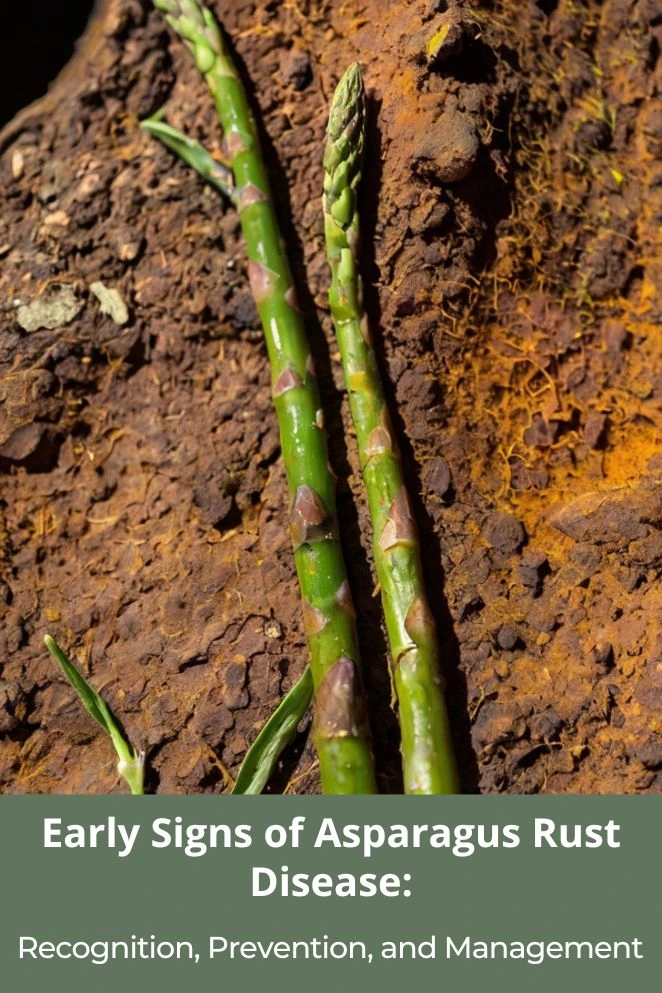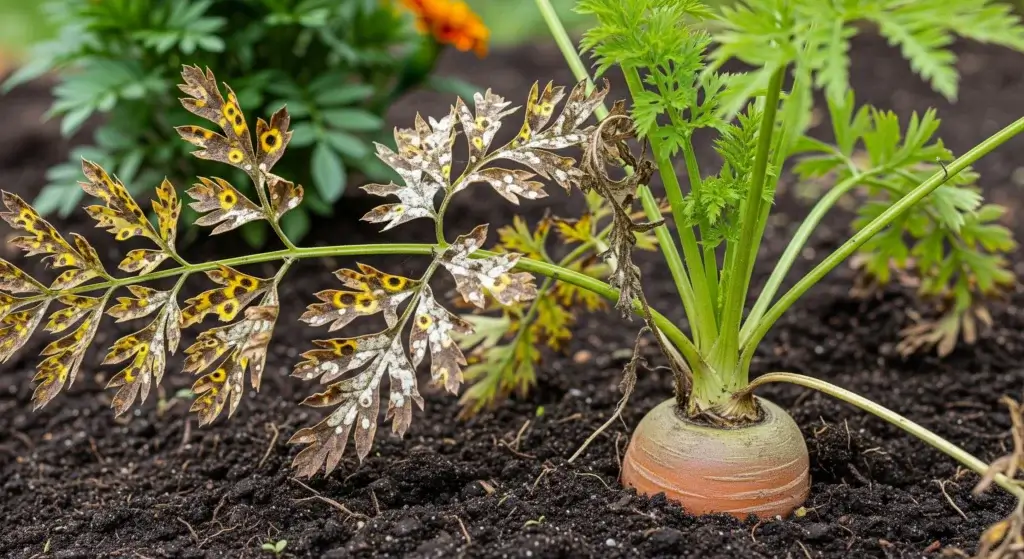
Asparagus rust is basically the boss-level enemy of asparagus—it can wipe out whole crops if you ignore it.
This guide’s here to help you spot the first warning signs, stop it before it spreads, and know exactly what to do if it shows up.
Think of it as your playbook for keeping your asparagus alive and thriving instead of watching it get wrecked by fungus.
The Critical First Signs: What to Look For
Spring symptoms on spears
Asparagus rust doesn’t kick down the door—it sneaks in.
The first signs show up in spring on young spears, and they’re easy to miss if you’re not paying attention.
Catching it early can save your whole patch.
Oval yellow spots
Look for tiny yellow ovals, about the size of a pencil eraser (6–19mm). Inside are fungal structures with fancy names—pycnia and aecia—but all you need to know is they’re the “baby factories” of rust.
They look harmless, but trust me, they’re the start of big trouble.
Raised, green pustules
Next, you might spot small, raised green bumps on the stems or new fern branches.
These little bumps are like the fungus waving hello.
Once you notice that weird texture, don’t ignore it—it’s a warning.
Early foliage symptoms
After harvest, when the ferns start growing, rust symptoms get louder and harder to miss.
Cream-colored lesions
By late spring or early summer, oval cream-colored spots show up on fern stems and branches.
Same 6–19mm size, but easier to spot.
They’re kind of the calling card of rust—other asparagus problems don’t look like this.
Blister-like appearance
As summer kicks in, you’ll see little blister-looking bumps on stems, branches, and even the skinny needle-like foliage.
These are called uredinia (don’t worry, nobody remembers that word), and they give the plant a bumpy, rough look.
Once you see these, you know the rust is moving in fast.
Progressive Symptom Development
To really beat asparagus rust, you’ve got to know how it levels up through the season.
The symptoms change as the months roll by, and spotting those changes helps you jump in with treatment before things get ugly.
Mid-season changes
Color transformation
Those early cream-colored spots don’t stay innocent-looking for long.
Within weeks, they shift into a reddish-brown shade—that’s where the “rust” name comes from.
It’s basically the fungus revealing its true colors.
Brick-red pustules
By mid-summer, the plants get covered with brick-red bumps that look dusty.
These pustules pump out clouds of rust-colored spores you can actually see with your eyes.
If you touch them, you’ll end up with red powder on your fingers—kind of cool, but also kind of terrifying if you realize that’s billions of spores.
Late season Indicators
Dark brown to black pustules
As fall rolls in, the pustules go dark brown, almost black.
That’s the fungus hunkering down for winter with survival-mode spores (teliospores, if you want the science-y word).
Foliage deterioration
Plants that get hit hard look wrecked—yellow, brown, dropping leaves way too early, with ferns dying back like they’re giving up.
The worst part? This crash drains the plant’s energy, so next year’s asparagus harvest is basically doomed before it even starts.
Environmental Conditions That Favor Disease Development
If you know what kind of weather asparagus rust loves, you can actually stay one step ahead of it.
This fungus is picky—but in the worst way, because the conditions it likes are super common in most gardens.
Temperature requirements
Rust thrives when temps sit between 55°F and 90°F (13°C to 32°C).
Yup, that’s pretty much the entire asparagus season in most places.
So instead of thinking “if it shows up,” assume it’s lurking, just waiting for the right moment.
Moisture conditions
Here’s the fungus’s secret weapon: water. The spores need a few hours of wetness on the plant surface to break in.
Where does that moisture come from?
- Morning dew (sneaky but deadly)
- Rain showers
- Overhead sprinklers (yeah, the kind that look pretty but drench everything)
- High humidity that makes the air feel like soup
- Crowded plants with no airflow (rust loves a cramped party)
Seasonal patterns
Rust usually kicks off in spring, right when those fresh spears are popping up.
Once it gets going, it cycles again and again through the summer—each round cranking out even more spores.
By late summer, it’s like the fungus is throwing an all-you-can-eat buffet at your asparagus bed, and the plants are the main course.
Impact on Plant Health and Yield
Catching asparagus rust early is a big deal, because once it takes hold, the damage isn’t just ugly—it’s long-lasting and brutal for your harvest.
Immediate effects
Spear quality reduction
Rust makes spears look gross—covered in spots and scars.
Nobody wants to eat asparagus that looks like it caught chickenpox.
Texture and flavor can tank too, which means it’s basically unsellable at a market.
Growth stunting
If the fungus nails young shoots right when they’re starting out, they might grow all weird, stay stunted, or just die.
That’s a straight-up loss in your harvest count before you even get started.
Long-term consequences
Photosynthetic capacity
Asparagus ferns are like solar panels—they soak up sun all summer to store energy for next year’s spears.
Rust wrecks those panels, so less energy means smaller or fewer spears next spring.
Crown weakening
The crown (the underground base of the plant) takes the hit too.
Over time, repeated rust infections weaken it so much that other diseases and stress wipe it out completely.
Dead crowns = replanting = starting over.
Yield reduction
In really bad outbreaks, harvests can crash by 30–60%.
And here’s the worst part—it doesn’t just ruin this year’s crop, it can mess with your yields for several seasons.
It’s like rust doesn’t just steal your harvest today, it robs your future too.
Early Detection Strategies
The best way to beat asparagus rust is to catch it early—before it spreads like wildfire.
That means having a solid routine for checking your plants, not just glancing at them when you walk by.
Regular scouting protocols
Weekly inspections
During the growing season, make it a habit to check your plants once a week. Look closely at:
- The lower parts of spears (rust likes to start low)
- Stem junctions and branch points on ferns (little hiding spots for fungus)
- Damp, crowded areas where air doesn’t move much (fungus’s favorite hangout)
Weather-based monitoring
After a stretch of rainy days, heavy dew, or swampy humidity, double up on your checks.
That’s prime rust weather, and it loves to move in when plants stay wet.
Diagnostic techniques
Visual identification
Train your eyes (and anyone helping you) to spot those early cream-colored oval lesions.
Once you know the look, you’ll never forget it.
Documentation
Snap pics on your phone of anything suspicious and keep notes—weather, where you saw it, and what you did.
It feels nerdy, but trust me, tracking patterns helps a ton.
Professional confirmation
If you’re not sure, don’t just shrug and hope. Send a sample to your local extension office or a plant lab.
Better safe than watching your asparagus bed crash and burn.
Prevention and Cultural Management
Alright, here’s the real deal: stopping asparagus rust before it shows up is like winning the game on easy mode.
Fixing it later? Total nightmare. Been there, done that, lost half a bed of asparagus because I got lazy. Don’t make my mistake.
Pick the right spot
Location is everything. Don’t plant your asparagus in some swampy, still-air spot where dew just hangs around like an awkward guest at a party.
You want a breezy area where the plants can actually dry out in the morning.
Think of it like choosing a locker—you’d never pick the one right under the leaky pipe, right? Same logic.
Give them space
When you plant, don’t shove them all together like sardines.
Asparagus needs breathing room. Good airflow = less fungus drama.
It’s basically giving each plant its own personal bubble.
Water smart
Always hit the soil, not the leaves.
Overhead watering is like trying to drink water by dumping it on your head—it’s messy and pointless.
A drip line or soaker hose is way smarter and keeps the plants dry where it matters.
Clean-up crew
End of the season? Chop down and clear out those old fern stalks.
Rust loves to camp out on dead plant stuff all winter like it’s got a season pass.
Leaving that junk is basically an open invitation for the fungus to come back stronger next year.
Choose strong varieties
Pro tip—start with asparagus that’s already bred to resist rust.
It’s like picking the tank character in a video game: built-in armor, fewer headaches. Why wouldn’t you start with the strong one?
Treatment and Management Options
Alright, so let’s say asparagus rust shows up. Don’t panic—but don’t sit around either.
This is one of those “move fast or regret it later” situations.
The quicker you act, the less chance this fungus has to throw a full-on takeover.
Fungicide applications
Here’s where science gets to flex. We’ve got some heavy hitters that can shut this fungus down:
- Mancozeb – kinda like a shield, it coats the plant and blocks infection.
- Myclobutanil – goes inside the plant, hunts the fungus down from the inside.
- Chlorothalonil – a broad-spectrum protector, like the general bodyguard of the fungicide world.
- Tebuconazole – honestly, one of the best at stopping rust right in its tracks.
Timing matters
The second you see those first weird spots, start spraying. Don’t wait.
Keep at it every 7–10 days as long as the conditions are right for rust.
And big tip here—don’t keep using the same product over and over, or the fungus will “learn” and come back stronger, like a boss fight that just leveled up.
Rotate your weapons.
Biological control options
If you’re more into the “nature fights nature” vibe, there’s Bacillus subtilis, a friendly bacterium that messes with the rust while boosting your plant’s overall health.
It’s like giving your asparagus a probiotic smoothie.
Integrated approaches
Honestly, the smartest move is mixing it all up: cultural practices (like airflow and cleanup), a little bio-control, and carefully timed fungicide.
That’s the long game—sustainable, effective, and way less stressful than playing catch-up every year.
Conclusion
Here’s the deal: if you want your asparagus to thrive, you’ve gotta be on rust patrol 24/7.
Those first little yellow spots? That’s your warning siren—ignore them, and the fungus will throw a party you definitely don’t want.
The secret sauce is simple: keep an eye out, act fast, and mix up your defenses—good airflow, resistant varieties, cleanup, and when needed, the right sprays or bio-helpers.
Think of asparagus like a long-term savings account—the effort you put in now pays you back for years.



